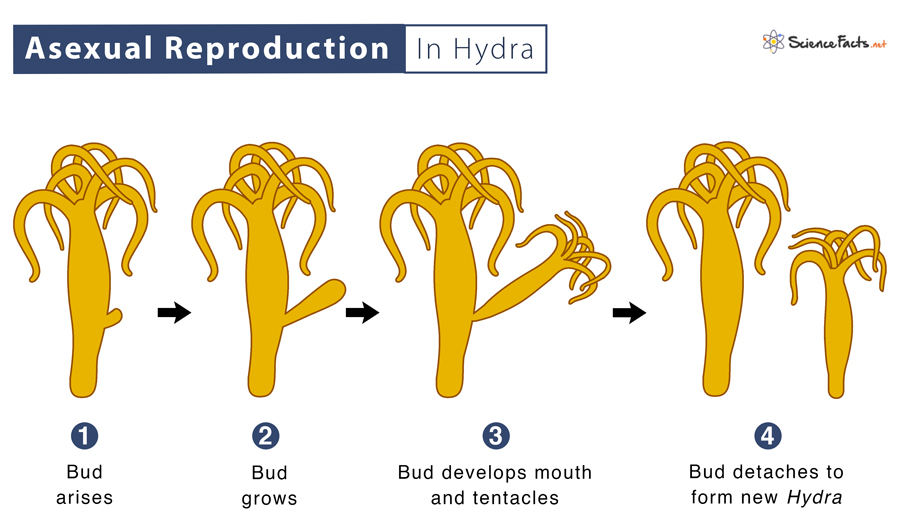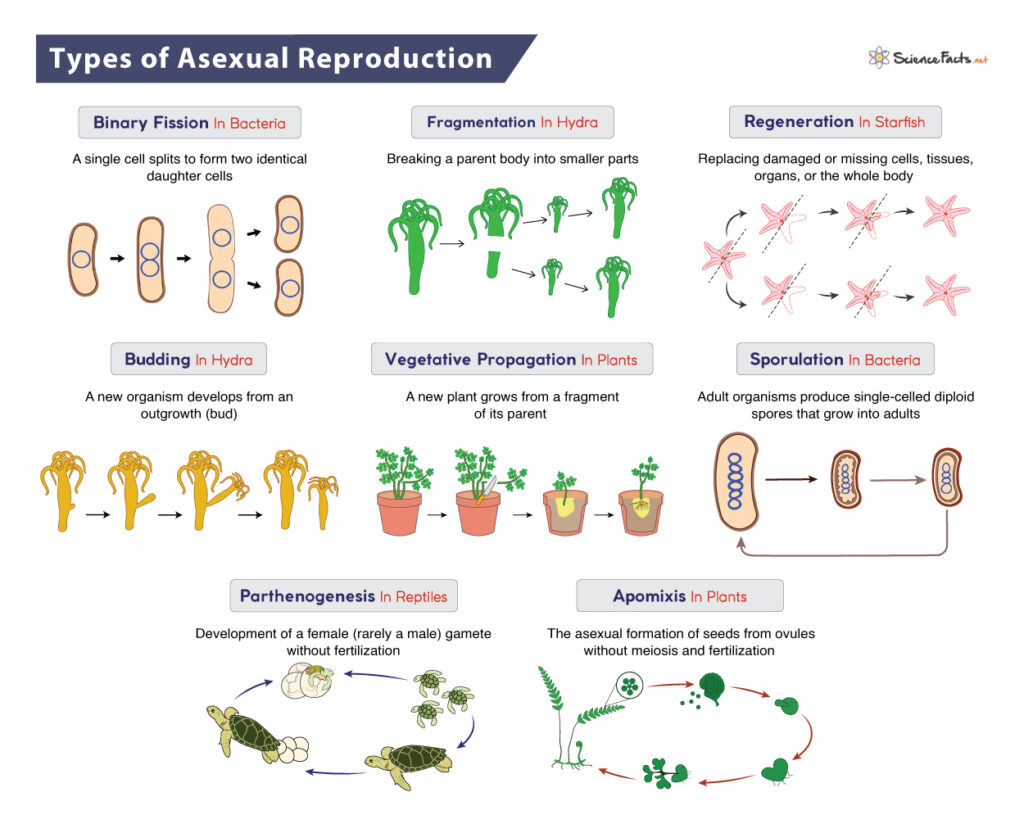Asexual Reproduction
Asexual reproduction is a reproduction mode in living beings that must have a single parent. Thus, unlike sexual reproduction, it does not require two sex cells or gametes to fuse. Asexual reproduction produces offspring genetically the same as the parent.
It is found in both prokaryotes and single-celled and multi-celled organisms eukaryotes.
Some other characteristics of asexual reproduction are:
- The organisms multiply and grow fast
- Have a short generation time
- Fertilization of the gametes does not occur
Types of Asexual Reproduction
There are many forms of asexual reproduction.
1. Binary Fission
Prokaryotes reproduce through binary fission, especially bacteria, archaea, and certain protozoans. The term ‘fission’ means to divide. Thus, in binary fission, the parent organism divides equally into two parts, each developing into a complete individual.
It is the simplest form of asexual reproduction that repeats itself within a short period, producing many organisms. Binary fission is thus a highly efficient form of reproduction in lower organisms.
Binary fission in protozoans can differ based on how the parent cell divides. For example, it can be irregular as found in amoeba, longitudinal as in Euglena, transverse as in Paramecium, or oblique as in Ceratium.
2. Fragmentation
As the name suggests, the body of the parent organism gets divided into multiple parts, and each part grows into a new individual.
Many plants such as gemmae in liverwort, most lichens (a symbiotic union of a fungus and cyanobacteria), algae such as Spirogyra, and fungi reproduce by fragmentation. Some animals that reproduce through fragmentation are planarians, many annelid worms, including planarians, and sea stars.
3. Regeneration
Organisms performing regeneration are capable of regenerating their lost body parts. It occurs by mitosis.
Lizards regenerating their tails, starfish growing their arms, and humans partly regenerating their liver are examples of organisms performing regeneration. Organisms like Hydra and planarians also exhibit regeneration.
4. Budding
It is the process by which the parent cell forms an outgrowth, which breaks away and forms the new individual. The daughter cell is initially more petite than the parent but attains the same size once they mature.
Budding is most commonly studied in Hydra. It is also found in some bacteria such as Caulobacter and Hyphomicrobium, parasites like Toxoplasma gondii, and worms Taenia, to name a few.
5. Vegetative Propagation
The natural form of vegetative propagation is most common in plants that reproduce without producing seeds or spores. Such plants reproduce using their vegetative parts, such as leaves, roots, stems, or buds. They then form their root and grow. Horticulturists use this method of reproduction in propagating economically important plants.
Plant like strawberry develops from rhizomes or stolons, while tulip and Dahlia form using bulbs or tubers of their parent. Similarly, miniaturized plants or plantlets such as kalanchoe develop from leaves. In contrast, plants like Begonia phyllomaniaca reproduce by forming adventitious shoots.
6. Sporulation (Spore Formation)
It is the process by which organisms reproduce by forming spores by a process called sporogenesis. Spores are dominant reproductive cells similar to seeds but, unlike them, lack the embryo, are thick-walled and are resistant to harsh environmental conditions.
The spores germinate back to reproduce once they get favorable environments. Many multicellular organisms form spores, including plants, fungi, and algae. Plants and many algae undergo sporic meiosis, where meiosis helps to form spores that develop into gametophytes without fertilization. Gametophytes then give rise to gametes through mitosis. Since asexual reproduction refers to the fusion of gametes, spore formation is considered a form of asexual reproduction.
Fungi and some algae, such as red algae Polysiphonia, involve spore formation without meiosis.
7. Parthenogenesis
It is a form of agamogenesis in plants that do not involve the formation of the male gamete. Here, an unfertilized egg develops into a new individual.
Parthenogenesis can be apomictic or automictic. In apomictic parthenogenesis, the egg cells produced by mitosis do not undergo meiosis and mature directly to form the embryo. Thus, the offspring are clones of their parent. In contrast, automictic parthenogenesis is one where the reproductive cell undergoes meiosis. Finally, the mature egg cell can develop into an embryo without fertilization by a sperm.
Parthenogenesis occurs in many invertebrates, such as aphids, stick insects, rotifers, ants, bees, and parasitic wasps. In vertebrates, it is found in reptiles, amphibians, and fish.
8. Apomixis in Plants
In certain plants, such as bryophytes and ferns, the gametophyte forms the sporophyte-looking offspring with the same number of chromosomes as the gametophyte. This process is called apogamy. Again, sometimes sporophyte may also give rise to a gametophyte-looking offspring having the same sets of chromosomes as the sporophyte. This process is called apospory.
In flowering plants, the seed formation from unfertilized ovules is called agamospermy, which can be of two types:
a. Gametophytic apomixes is the process where the embryo develops from an unfertilized ovum from a gametophyte, formed from a cell where the meiosis is incomplete.
b. Sporophytic apomixes is the process where the embryo does not arise from a gametophyte but from other cells such as the nucellus or an integument.
Advantages of Asexual Reproduction
This type of reproduction has several benefits over sexual reproduction. They are:
- It helps in the rapid growth of the population, and thus the organisms have a relatively short generation time.
- It does not need a mating partner and thus saves time and energy. Asexual reproduction is less costly than sexual reproduction.
- Colonization into a habitat is fast.
- It can be used in tissue culture techniques to propagate plants in large quantities with the desired characteristics (economic benefit).
Disadvantages of Asexual Reproduction
However, the asexual mode of reproduction has a big drawback.
- Organisms generated by asexual means have less genetic diversity due to the absence of recombination and segregation. Thus, the whole group is at high risk of extinction due to a change in the environment, disease, or mutation, as they all are clones and carry the same genes.
-
References
Article was last reviewed on Friday, October 6, 2023





